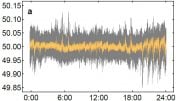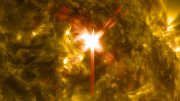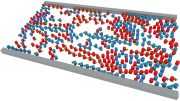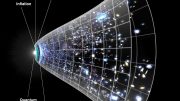
Recent research challenges the conventional division between ‘thinking’ and ‘doing’ molecules within cells, showing that structural ‘muscle’ molecules can also process information and make decisions through nucleation. This discovery, highlighting a dual role for these molecules, could lead to more efficient cellular processes and has broad implications for understanding computation in biological systems. Credit: Olivier Wyatt, HEADQUARTER, 2023 https://headquarter.paris/
We tend to separate the brain and muscle – the brain does the thinking; the muscle does the doing. The brain takes in complex information about the world, makes decisions, while muscle merely executes. This distinction extends to our understanding of cellular processes, where certain molecules within cells are perceived as the ‘thinkers’, processing information from the chemical environment to determine necessary actions for survival, while others are viewed as the ‘muscle’, constructing the essential structures for the cell’s survival.
But a new study shows how the molecules that build structures, i.e, the muscle, can themselves do both the thinking and the doing. The study, by scientists at Maynooth University, the University of Chicago, and California Institute of Technology was published in the journal Nature.
“We show that a natural molecular process – nucleation – that has been studied as a `muscle’ for a long time can do complex calculations that rival a simple neural network,” said University of Chicago Associate Professor Arvind Murugan, one of the two senior co-authors on the paper. “It’s an ability hidden in plain sight that evolution can exploit in cells to do more with less; the `doing’ molecules can also do the `thinking.’”
Thinking using physics
Cells need to recognize the environment they are in and do different things to survive. For example, some combinations of molecules might indicate a time of stress that requires hunkering down while other combinations of molecules might indicate a time of plenty. But the difference between these molecular signals can be subtle – different environments might involve the same molecules but in different proportions.
Dr Constantine Evans, Research Fellow at the Hamilton Institute, Maynooth University, the lead author of the study, explained that it is a bit like walking into a house and smelling freshly baked cookies, versus smelling burning rubber. “Your brain would alter your behavior depending on you sensing different combinations of odorful chemicals. We set out to ask if just the physics of a molecular system can do the same, despite not having a brain of any kind,” he said.
The traditional view has been that cells might be able to sense and respond in this way using molecular circuits that conceptually resemble electronic circuits in your laptop; some molecules sense, other molecules make a decision on what to do, and finally `muscle’ molecules carry out an action (e.g., build a structure).
The alternative idea explored here is that all of these tasks – sensing, decision making, response – can be accomplished in one step by the physics inherent to the `muscle’ itself. The physics involved in this study is that of “phase transitions” – think of a glass of water freezing when it hits 0 °C; first, a little fragment of ice `nucleates’ and then grows out until the whole glass of water is frozen.
On the face of it, these initial steps in the act of “freezing” – nucleation – do not resemble `thinking’. But this work shows that the act of freezing can “recognize” subtly different chemical combinations – e.g., the smell of oatmeal raisin cookies vs chocolate chip – and build different molecular structures in response.
Robustness in experiments
The authors tested the robustness of nucleation-based decision-making using DNA nanotechnology, a field that Prof Erik Winfree helped pioneer. “The theory is general and should apply to any kind of molecule. But DNA lets us experimentally study nucleation in complex mixtures of thousands of kinds of molecules and systematically understand the impact of how many kinds of molecules there are and what kinds of interactions they have”, explained Erik.
The experiment revealed a few surprises – `muscle’-based decision making was surprisingly robust and scalable. Complications not modeled in theory, such as running out of molecules during the experiment, turned out to help rather than hurt. As a result, relatively simple experiments solved pattern recognition problems involving around a thousand kinds of molecules, nearly 10-fold larger than in earlier circuit-based approaches. In each case, the molecules came together to build different nanometer-scale structures in response to different chemical patterns – except the act of building the structure in itself made the decision on what to build.
The work points to a new view of computation that does not involve designing circuits but rather designing what physicists call a ‘phase diagram’; e.g., for water, a phase diagram might describe the temperature and pressure conditions in which liquid water will freeze or boil. Conventionally, phase diagrams are seen as describing `muscle’-like material properties. But this work shows that the phase diagram can also encode `thinking’ in addition to `doing’ when scaled up to complex systems with many different kinds of components.
“Physicists have traditionally studied things like a glass of water which has many molecules but all of them are identical. But a living cell is full of many different kinds of molecules that interact with each other in complex ways. This results in distinct emergent capabilities of multi-component systems,” said Dr Jackson O’Brien, who was involved in the study as a University of Chicago graduate student in physics. The theory in this work drew mathematical analogies between such multi-component systems and the theory of neural networks; the experiments pointed to how these multi-component systems might learn the right computational properties through a physical process, much like the brain learns to associate different smells with different actions.
While the experiments here involved DNA molecules in a test tube, the underlying concepts – nucleation in systems with many kinds of components – applies broadly to many other molecular and physical systems. The authors hope this work will spur work to uncover hidden `thinking’ abilities in other multi-component systems that currently appear to merely be `muscles.’
Reference: “Pattern recognition in the nucleation kinetics of non-equilibrium self-assembly” by Constantine Glen Evans, Jackson O’Brien, Erik Winfree and Arvind Murugan, 17 January 2024, Nature.
DOI: 10.1038/s41586-023-06890-z
Funding was provided by the National Science Foundation (USA), the Evans Foundation for Molecular Medicine, the European Research Council, Science Foundation Ireland, the University of Chicago Materials Research Science and Engineering Center, the Simons Foundation, and the Carver Mead New Adventures Fund.









I had recently read about the Blood brain barrier that has the use of filtering blood to the brain the research has shown molecule size particles are not allowed through, if this molecule is assembled it must have attributes of the smaller passing parts of the blood, which makes me think that any disorder in the brain may be caused by a blockage created at the blood brain barrier, Alzheimer’s, dementia, Parkinson’s, multiple sclerosis, nerve disorders.
Substances cross the blood-brain barrier (BBB) by a variety of mechanisms. These include transmembrane diffusion, saturable transporters, adsorptive endocytosis, and the extracellular pathways.
Please answer:
1. Why is mathematics the language of science?
2. What is the basis for mathematics as the language of science?
3. What is the difference between mathematical graphics and physical reality?
4. What is the difference between human thinking and physical reality?
5. What is the difference between low dimensional spacetime matter and high-dimensional spacetime matter?
6. Is human thinking a physical reality?
and so on.
Science must follow mathematical rules. For example, the Standard Model (SM) is considered to be one of the most significant achievements of physics in the 20th century. However, the magnetic moment of μ particle is larger than expected, revealed by a g-2 experiment at Fermilab, suggests that the established theory (such as SM) of fundamental particles is incomplete. Furthermore, the SM omitting gravity, it not involved the time problem and when the particle movement starts. Mathematics is the foundation of science. Physics must respect the scientific nature of mathematics and mathematical models. The SM must be based on mathematical models in order to be scientific, convincing, and in line with natural laws.
I hope researchers are not fooled by the pseudoscientific theories of the Physical Review Letters (PRL), and hope more people dare to stand up and fight against rampant pseudoscience.
The so-called academic journals (such as Physical Review Letters, Nature, Science, etc.) firmly believe that two high-dimensional spacetime objects (such as two sets of cobalt-60) rotating in opposite directions can be transformed into two objects that mirror each other, is a typical case of pseudoscience rampant.
If researchers are really interested in Science and Physics, you can browse https://zhuanlan.zhihu.com/p/643404671 and https://zhuanlan.zhihu.com/p/595280873.
Please think carefully:
1. Why is mathematics the language of science?
2. What is the basis for mathematics as the language of science?
3. What is the difference between mathematical graphics and physical reality?
4. What is the difference between human thinking and physical reality?
5. What is the difference between low dimensional spacetime matter and high-dimensional spacetime matter?
6. Is human thinking a physical reality?
and so on.
This is fascinating, but hardly surprising. There have been hints towards body parts having some type of memory function in transplant patients where the patient gains some characteristic from the original host which could only be explained by the transplanted organ / limb having some kind of memory function.
This is what Anil Seth is against. Polluting intuition, divorcing from the eternal – a knee jerk against the poignant as opposed to correct direction from cns. I wrote on the blood barrier to brain in a wholly different local context of India, how cows can change circadian rhythms and fix against nerve rattle diseases by way of Calf Thymus homeopathy if not allopathy surety. Thanks. Live from India.
Very advanced and technical information. In 12 step, we replace our old thinking patterns, that become dysfunctional in our adult lives, with a spiritual solution that inspires and innovates our development.The Sunlight of the Spirit and reality are so empowering and freeing. Thank you.
Thank you.